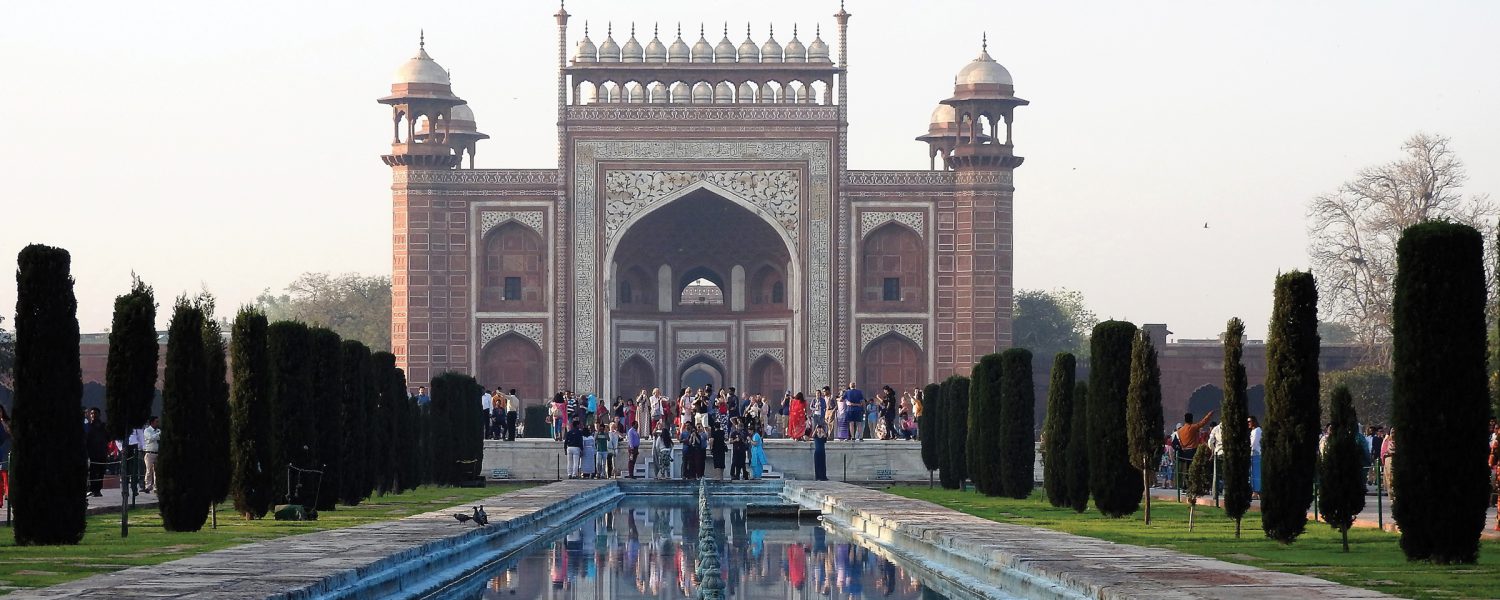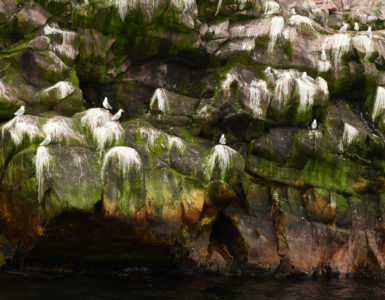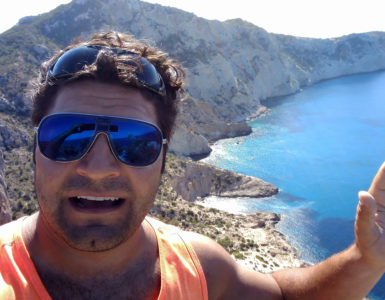Taking Holy Cows and Painted Elephants in Stride
Story by Karen Paton-Evans
Photography by Pam and Bill Seney
Edging their way toward the holy Ganges River in northern India, two Windsor couples were caught up in an endless stream of Hindus on pilgrimage and attending the final passage of loved ones.
“Imagine 200,000 people, like the city of Windsor, on one road. That was the most people I’d ever seen in my life. There were only a couple inches between people and bikes and tuk-tuks, yet we never saw anyone get hurt,” says Bill Seney.
He and his wife, Pam, and friends Maria and Roger Bramhall didn’t encounter all of India’s nearly 1.4 billion residents while touring the country, but at times, it seemed possible. Home to approximately one-sixth of the people living on Earth, India is definitely bustling.
The travelers were drawn to India by its ancient culture and modern vibe. Enriched by thousands of years evolving its mathematics, astronomy, architecture, literature, music and the fine arts, India has entered a new era of innovation and for some, prosperity.

While planning the trip, “we had all talked about wanting to see the Taj Mahal, the Pink City and the Ganges,” Roger says. Always up for adventure, in early spring 2018, the friends flew from Toronto to Dubai and on to Delhi for a 12-day tour of India.
The country’s capital is divided into Old Delhi, the historic city that was the seat of Muslim rulers from the 1600s to 1857, and New Delhi, built in the early 1900s during the British Crown’s rule over much of India (lasting from 1858 to 1947).
On Mar. 23, the Canadians entered Old Delhi to see the Red Fort, built of red sandstone in 1648. Ever since the nation secured its independence from Britain 72 years ago, the prime minister of India hoists the flag above the octagonal fort’s domes to celebrate Independence Day every Aug. 15.
Further evidence of the architectural vision of 17th century Mughal Emperor Shahjahan, builder of the Red Fort and Taj Mahal, is the Jama Masjid mosque. Constructed of red sandstone adorned with white marble, the mosque can receive 25,000 people in its courtyard.
Mahatma Gandhi, regarded as the father of the nation for leading India to independence, is remembered for his strategic nonviolent civil disobedience. Raj Ghat, a black marble memorial platform glowing with an eternal flame, was raised on the spot where he was cremated on Jan. 30, 1948, a day after his assassination. The Canadians paid their respects to the activist who continues to inspire global civil rights movements.
In a land rich in Indo-Islamic architecture, the travelers wondered how high a minaret would go. They learned firsthand at the Qutab Minar, a UNESCO World Heritage Site, where the planet’s tallest stands 73 metres.
Pausing the cultural tour for a retail break, the Bramhalls and Seneys caught rides on bicycle tuk-tuks through Chandni Chowk, an old bazaar with twisted alleys crammed with traditional artisans selling their wares.
A five-hour drive next day brought the travelers to Agra, the medieval city that boasts the Taj Mahal. Before seeing the masterpiece, they did an architectural warmup with a visit to the Baby Taj, the Tomb of Itmad-Ud-Daulah, thought to be a draft for the Taj Mahal.

Rising early on Mar. 25, the Canadians dressed carefully in the colourful long tunics, trousers and scarves worn throughout India. “Our beautiful outfits were given to us by Indian friends in Windsor. We felt glamourous and comfortable,” Pam says. “They helped us feel like we fitted in with everybody as we partook of the culture.”
The special outfits were donned in honour of the visit to the Taj Mahal. “We were so pumped to go!” Maria says.
Commissioned by the Mughal emperor Shah Jahan as a memorial to his beloved wife Mumtaz Mahal, the Taj turned rose and gold in the rising sun’s rays, delighting the Canadians standing before its white marble walls.
Construction of the Taj mausoleum began in 1632, with 20,000 workers labouring for nearly seven years. The octagonal tomb is harmoniously balanced with arches and minarets, culminating in a huge dome rising above the centre.
“The intricacy of the craftsmanship inside and out is very interesting, with ornate marble carvings on the walls, ceilings – everywhere,” Roger says. Filigreed marble screens, panels and other features are inlaid with 28 types of precious and semi-precious stones. “When the sunlight shines through the coloured stones, it’s dazzling.”
“The Taj was originally built to withstand earthquakes. It’s an engineering marvel,” Bill notes.
Surviving wars, plundering and periods of neglect, the Taj’s modern threats are environmental. To help control the acid rain that is turning the white marble yellow, the Indian government has regulated emissions by establishing the Taj Trapezium Zone, a 10,400-square-kilometre area surrounding the mausoleum.
By this point of the journey, Pam was feeling overwhelmed by the presence of so many people and eager to meet four-legged residents, preferably with orange fur and black stripes. The friends went on two safaris in the Ranthambore National Park, a tiger reserve between the Aravalli and Vindhya mountain ranges.
“We saw all the tiger food: various deer, jackals, mongoose, owls, crocodiles, blue bull antelope, langar monkeys and tigers’ favourite food – sambar deer,” Roger says.
“Sadly, we only got a glimpse of the backend of a tigress as she walked into a bush,” says Pam. “Royal Bengal tigers are very solitary and so it’s not easy to spot them on safari. They’re very elusive. We waited hours and hours hoping the tigress would come back out. It was also very hot, one of the reasons the tigers weren’t out and about.”
Animals that would startle Windsorites if they spotted them meandering along Tecumseh Road were commonplace in India’s rural villages and huge urban centres. Pam was thrilled to see camels and monkeys all over the place, including a herd of wild camels clomping together near Jaipur.

Jauntily painted, an elephant carries passengers down the road. 
The 42 metre high arched India Gate in New Delhi. 
A Rajasthani dancer balances a fire bowl on her head as she entertains dinner guests.
“In every city we were in, cows had the right of way. They are considered sacred by Hindus, who comprise about 80 percent of the country’s population,” says Roger. With six million cows roaming freely in India, “residents collect cow pies, dry them on the roadside and then burn them as fuel. That heats a lot of homes.”
“The cows are well-fed. We didn’t see any skinny ones. There were also piles of offerings that people left in little temples,” Maria says. “The smell of incense was everywhere.”
Elephants painted with colourful motifs are a slow mode of transportation in Jaipur, the Pink City. Observing that Jaipur is a soft, earthen pink, “not Barbie pink,” Pam was charmed by the tale of the maharaja ordering the entire city to be painted pink, the colour of hospitality, to welcome the Prince of Wales when he visited in 1876. By law, residents must keep painting their town pink to this day.
The Bramhalls and Seneys toured Jaipur in tuk-tuks. “We went to artisan shops where they handmake carpets, tables inlaid with mother-of-pearl and jewellery with semiprecious stones. The workmanship is unbelievable,” Roger says.
While Pam loaded up on metal and glass bangles, Bill purchased an oil painting of tigers. He recalls, “I was here on business 30 years ago. Much has dramatically improved. They now have buildings instead of tents for stores.”
Enticed by tailors to have custom suits made, Roger and Bill were pleased when their new clothes were delivered next day to their hotel. “The suits fit perfectly and we’re very happy with the quality,” Roger says.
Open to new experiences, the friends traveled to Varanasi (also called Kashi), an ancient, cultural city on the Ganges River. It is a sacred city in Hinduism and Jainism, calling to pilgrims from around the globe.
“Pious Hindus believe that to be cremated on the banks of the Ganges is to attain release from the cycle of birth and death,” Roger says. “Their ashes are scattered in the river.”
Stone slab steps called ghats line the riverbank. Most are reserved for the devout as they pray and ritually bathe. Other ghats are for open air cremations and are alight with funeral pyres continuously burning.
“We saw bereaved families waiting their turn on the steps,” Bill says. “It was an experience we’re not used to, but very interesting.”
Visiting the ghats at night, the Bramhalls and Seneys were transfixed by the impact of prayers, fragrant oils and flowers. They returned in the morning to board one of the many small boats on the river.
On their last night in India, the friends attended a dinner show, where dancers performed with multiple bowls stacked on their heads. “The top bowls were aflame,” Maria says.
“We loved eating Indian food, so flavourful and spicy,” says Bill. “Roger and I became very adventurous and enjoyed the experience.”
“We’re all glad we went,” Pam says. “We know now why they call it Incredible India.”
On the way home, the friends paused for a week in modern, mesmerizing Dubai. Their travels are being featured in an upcoming issue of Windsor Life.






Add comment